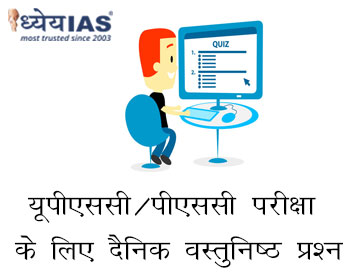Current Affairs MCQs Quiz for UPSC, IAS, UPPSC/UPPCS, MPPSC. BPSC, RPSC & All State PSC Exams
Date: 16 January 2023
Q1. Consider the following statements with respect to Female Labour Force Participation:
1. India’s female labour force participation rate is the
second lowest among the BRICS countries ahead only of Brazil.
2. India’s female LFPR is now among the world’s lowest at around 10%.
Which of the statements given above is/are correct?
(a) 1 only
(b) 2 only
(c) Both 1 and 2
(d) None of the above
Answer: (D)
Explanation:
- India’s female labour force participation (FLFP) rate is the lowest among the BRICS countries and is also lower than some of its neighbouring countries in South Asia such as Sri Lanka and Bangladesh. Thus, statement 1 is incorrect.
- India’s female LFPR is now among the world’s lowest at around 20%, on par with countries like Saudi Arabia. Thus, statement 2 is also incorrect.
Q2. Consider the following statements:
1. The Constitution of India defines its ‘basic structure’ in
terms of federalism, secularism, fundamental rights, and democracy.
2. The power of ‘judicial review’ is part of the ‘basic structure of the
doctrine’.
Which of the statements given above is/are correct?
a) 1 only
b) 2 only
c) Both 1 and 2 only
d) Neither 1 nor 2
Answer: (B)
Explanation:
- The doctrine was evolved by the Supreme Court in the 1973 landmark ruling in Kesavananda Bharati v State of Kerala. Supreme Court defines it from time to time. It is not defined by the constitution of India. So, statement 1 is incorrect.
- The Supreme Court has declared the power of judicial review as a basic feature of the Constitution or an element of the basic structure of the Constitution. So, statement 2 is correct.
Q3. Consider the following statements on Right to Legal Aid:
1. Article 39-A directs the State to ensure that the
operation of the legal system promotes justice on a basis of equal opportunity
and shall, in particular, provide free legal aid by suitable legislation or
schemes.
2. Right to free legal aid or free legal service is an essential fundamental
right guaranteed by the Constitution of India. It forms the basis of reasonable,
fair and just liberty under Article 21.
Which of the statement/s given above is/are correct?
a) 1 only
b) 2 only
c) Both 1 and 2
d) Neither 1 nor 2
Answer: (C)
Explanation:
Right to Legal Aid – A Constitutional Commitment
- Article 39-A directs the State to ensure that the operation of the legal system promotes justice on a basis of equal opportunity and shall, in particular, provide free legal aid by suitable legislation or schemes or in any other way, to ensure that opportunities for securing justice are not denied to any citizen by reason of economic or other disabilities. (Hence option 1 is correct).
- Right to free legal aid or free legal service is an essential fundamental right guaranteed by the Constitution of India. It forms the basis of reasonable, fair and just liberty under Article 21, which says, “No person shall be deprived of his life or personal liberty except according to procedure established by law”. (Hence option 2 is correct).
- In State of Maharashtra v. Manubhai Pragaji Vashi, the Supreme Court has made it clear that it is now well established that the failure to provide free legal aid to an accused at the cost of the State unless refused by the accused, would vitiate the trial.
- In M.H Hoskot v. State of Maharashtra, Justice KrishnaIyer observed that providing free legal aid is the State's duty and not government's charity.
As both the statements are correct so correct option is option (c).
Q4. Consider the following statements regarding the ‘Deepfakes’ and related technology
1. Deepfakes are digital media edited and manipulated using
Artificial Intelligence and are used to create hyper-realistic digital
falsification.
2. Deepfake techniques use a deep learning technique called autoencoder.
Choose the CORRECT answer using the codes given below:
a) 1 only
b) 2 only
c) Both 1 and 2
d) Neither 1 nor 2
Answer: (C)
Explanation:
- Deepfakes are digital media - video, audio, and images edited and manipulated using Artificial Intelligence to create hyper-realistic digital falsification.
- Cybercriminals and even mischievous elements use AI softwares to superimpose a digital composite onto an existing video, photo or audio with a high potential to deceive people.
- Digital composite: Method of assembling multiple media files to make a final media file which consists of elements of different files.
- Deepfake techniques can be used to synthesize faces, replace facial expressions, synthesize voices, and generate news.
- Hence, statement-1 is correct.
- Deepfake techniques rely on a deep learning technique called autoencoder, which is a type of Artificial Neural Network (ANN) which contains an encoder and a decoder.
- Hence, statement-2 is correct.









